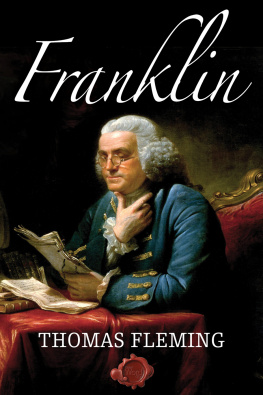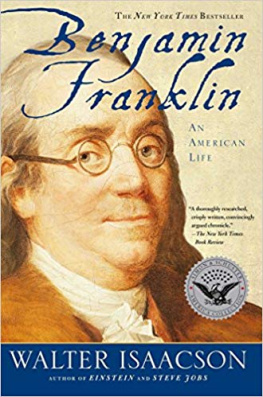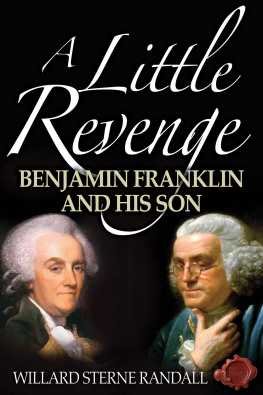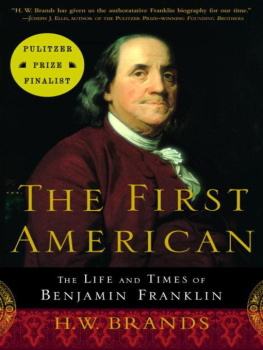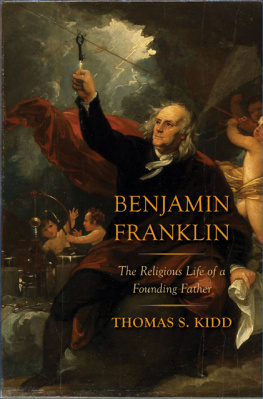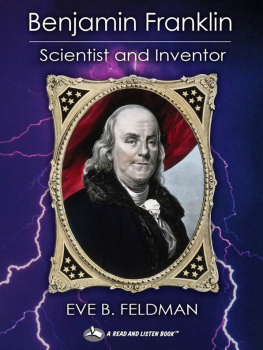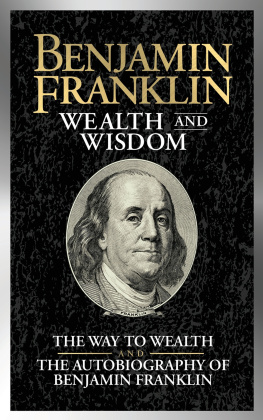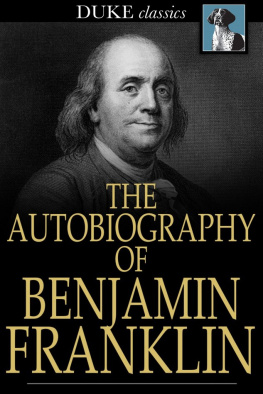The sky above Philadelphia began changing from the bright sunshine of a June day to a gloomy gray. Soon over the neat, red-brick colonial city rolled a wave of hulking black clouds. Windows slammed shut. Tradesmen closed doors left open to relieve the sweltering heat. Mothers called their children indoors. Idlers vanished from street corners into the nearest tavern. Philadelphia was about to experience that natural phenomenon known as a thunderstorm. People hoped it would lessen the humidity and the heat, which often made summertime Philadelphia feel like Equatorial Africa, but they also shivered with dread at the first rumble of thunder. Those black clouds carried in them dangerous bolts of lightning.
Only one person in the city greeted the oncoming storm with sheer delight. Benjamin Franklin had been waiting impatiently for conditions like these for days. In his comfortable home on the southeast corner of Race and Second Streets, he called excitedly to his twenty-one-year-old son William. Billy, as his family called him, soon appeared. He was a strapping young man, over six feet in height, two or three inches taller than his father, although he lacked his fathers almost bear-like chest and shoulders. William carried himself with the confident, martial erectness of a soldier. Handsome was the only word to describe his small but fine-featured face. He shared his fathers high forehead and firm chin, but his mouth was not as relaxed or as pleasing in appearance. Now it was attractive enough because William Franklins face was aglow with excitement.
Is everything done? Benjamin Franklin asked. William nodded. Quickly they slipped into their loose-fitting cloth coats and hurried into the next room. There on a long table stood a variety of strange machines and instruments - glass tubes and jars bound with strips of tin, glass globes on spindles, silk strings dangling from the ceiling. To anyone acquainted with eighteenth-century science, this apparatus - in particular, the tubes and the tin-encased jars - meant that this was the laboratory of someone investigating the mysteries of electricity. For the last four years, this exploration had occupied almost all of Benjamin Franklins days and nights. To find the extra hours he needed, he had resigned from his printing business, sacrificing half of his annual income, and moved to this house on the outskirts of Philadelphia where he was less accessible to his many friends.
When Franklin began his experiments, the world of science viewed electricity as a curiosity. Experimenters created electrical fire by rubbing glass tubes with silk. They then stored the accumulated charges in tin-lined bottles, called Leyden jars, named for the university where their creator first made them. But beyond the fact that electricity created magical effects - for instance, it could animate a piece of twisted wire so that it looked like a living spider or, in a darkened room, cause the gold border on an expensive book to glow - no one knew terribly much about it. In a series of classic experiments, Franklin had transformed electricity from a curiosity to a full-fledged branch of science. He had discovered the existence of plus and minus charges and invented such terms as battery, conductor, and condenser. Now he was about to challenge his most daring hypothesis - that electricity and lightning were identical.
As the first patter of rain pelted the windows, William Franklin took from a dark corner of the laboratory a strange looking kite made from a large, thin silk kerchief. To the top of the vertical stick he fastened a pointed wire about fifteen or sixteen inches long. Benjamin Franklin took a Leyden jar and concealed it under his loose coat. Then down the stairs and out the door the two of them went. They hurried through the scattering rain to an open field not far from their house, part of the commons or grazing grounds of Philadelphia. On one side of the field was a shed, where people who grazed their cattle could take refuge from rain or sun. While Franklin stood inside the shed, William ran across the pasture and got the kite aloft in the tricky, gusty wind of the gathering storm. Then he, too, retreated under the shed.
William Franklin must have felt a little foolish, flying a kite in the rain, but he did not look nearly as funny as his father would have prancing across the commons on the same errand. There was the strong chance that the hypothesis was wrong. If so, Benjamin Franklin did not want people laughing at him in the streets or asking where he got his outrageous idea about lightning. He knew William would keep quiet if the experiment failed.
There was another reason why William came along with his father. The experiment was dangerous. Franklin knew electricity could kill; he had killed animals with it in his laboratory. Twice, by accident, he had knocked himself unconscious with it and, in another experiment, had prostrated six grown men with a single charge. He also knew that lightning was far more powerful electricity than anything he had created in his laboratory. He had seen it reduce the metal part of a roof to molten jelly. This was not an experiment one could call on a friend to share. Only his son, who had already taken many lesser risks in the laboratory, could join Benjamin Franklin at this climactic moment.
In a few minutes, the kite was only a small dancing dot in the gloomy sky. William handed the kite string to his father. To the end of the twine was tied a silk ribbon. Silk did not conduct electricity; it was an insulator. This was the only safeguard Franklin used against the deadly amount of electricity in the clouds above him. Contrary to the traditional Currier and Ives print, which shows Franklin and his son (pictured as a small boy) gleefully rejoicing when a bolt of lightning hit the kite, this was the last thing Franklin wanted. The pointed wire at the top of his kite was designed to draw off some of the clouds electric charge, just as a pointed conductor attracted electricity from a charged body in the laboratory. There was no need, much less a desire, for the massive and dangerous discharge of a lightning bolt. Where the twine and the silk joined a small house key was fastened. This was where Franklin hoped the electricity would appear. Again and again, he touched the key with his knuckle. Nothing happened.
Over the city, the storm increased in fury. Thunder rumbled, and lightning glinted. Then William pointed excitedly toward a massive cloud moving downwind toward them. On it came, booming thunder while it passed directly over their heads. The little kite danced and dived in the gusts of turbulence. Again Benjamin Franklin touched the key with his knuckle - surely now. His face fell. The key was as cold as it had been the day it was cast.
Now the sky was so black it was impossible to tell one cloud from another. More rain began to fall. The kite whirled and twisted and dived. Close to despair, Franklin gave up touching the key and stared disconsolately up at the murky sky. He thought about the hundreds of experiments he had conducted, the studies he had made of the effects of lightning on houses and trees, trying to see where he had gone wrong. Then his eyes drifted toward the string in his hand. With an exclamation of triumph, he clapped his son on the back and pointed excitedly at the twine.
The loose threads were standing erect, separate from each other, just as if they had been electrified when he had suspended them on a laboratory conductor. Cautiously Benjamin Franklin moved his knuckle toward the key. Through his hand and up his arm rushed that familiar tingling, shocking sensation that experimenters called an electric spark. Again and again he touched it, and then he let William touch it.

